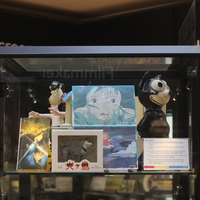Isle of Dogs Action Figure
Dublin Core
Title
Isle of Dogs Action Figure
Subject
Action figure based on stop-motion puppet
Description
“Isle of Dogs Action Figure” (EXEBD, 999029) is a small, plastic figure of the character Duke from Isle of Dogs (2018), who is a grey and white dog. The toy can be posed by moving its legs and jaw and rotating its head. It is made of hard plastic and is painted to add detail. The toy is still in its original packaging, which is relatively plain and white and says the name of the movie, the name of the character and the term ‘action figure’ in English and Japanese. The action figure comes from a collection of six made in limited editions by the Twentieth Century Fox Film Corporation to promote the movie.
The action figure’s design is based on puppets created by Andy Gent for the stop-motion animation film The Isle of Dogs (2018). This was Gent’s second collaboration with director Wes Anderson, having previously worked with him on Fantastic Mr. Fox (2009). A part of the marketing for the film was the puppetry and the fact that this film held the record for the largest number of puppets created by hand for a stop-motion film, therefore making a set of action figures that could be collected to promote the film capitalised on this marketing. As a result of the item being based on a puppet, it is not easy to determine who holds the copyright to what aspects of the design, as Gent should hold the intellectual copyright to his puppet design. It is most likely that he only has rights to the design as a puppet, seeing as the toy was able to be created in its likeness.
The term ‘action figure’ is used on the box to describe the item, which is a term that Jason Bainbridge points out is loaded, “The appellation ‘action figure’ contains two equally important parts – an action and a figure – and it was the ‘figure’ that came first,” (Bainbridge, 830) he goes onto explain how dolls of adult women, such as barbie, acted as a precursor to the invention of the ‘action figure’ embodying the ‘figure’. They created a space where young girls could envision themselves as fashionable adults as well as establishing “conceptions of what it means to be a child occupying a combination of gender, racial and class positions in society” (Giroux, 89). However, these dolls did not incorporate much ‘action’ as they were capable of minimal movement. It was not until 1963, when G.I.Joe was invented, that a plastic toy was capable of greater movement, “Through his 21 moveable parts, Joe brought ‘action’ to the children’s toy in a way that had never been seen before” (Bainbridge, 831). G.I. Joe was purposefully not marketed as a doll for fear it would link him too closely to the feminine gendering of toys like Barbie. Instead, he was labelled “moveable fighting man” and later “action man” to combat this. It was not until the 1970s, with the introduction of the Transformers toys, that an ‘action figure’ could begin to be a non-human shaped toy, prioritising the appeal of movement abilities over a masculine alternative to the term doll. The choice to classify this item as an ‘action figure’ links it to this expectation of movement, which makes sense as the toy is modelled after the stop-motion puppet whose main purpose was to be poseable, which allowed the filming to be possible.
The plain design of the box, as well as the collection’s limited release, suggests that instead of a toy, this item should be more accurately considered a collector’s item. This is further supported by the fact that there was another set of these figures that were more expensive as they were more detailed. The figures had fur and were hand-finished by some of the artists who worked on the film puppets. This may not be surprising for an item intended to promote a film made in 2018, as “the romantic notion of the toy playing child has been challenged in the 21st century as toys are increasingly identified as objects of adult fandom” (Heljakka, 240). Aiming action figures towards adults has become increasingly more common as children seem to lose some interest; in the context of Isle of Dogs, the film is a PG-13, meaning it is meant for young teenagers and older.
Unlike many other items in this collection, the action figure is on display at the Bill Douglas Cinema Museum. It is in a display of ‘animation’ alongside items from Pokémon and Studio Ghibli, which contextualise this display as examples of Japanese animation, as both of those brands are Japanese, even though despite being set in the fictional city Megasaki in Japan Isle of Dogs is not a Japanese production. Instead, it was American-German co-production. It’s place in the display also presents it as an example of a contemporary cinema as all the items with it are from productions no older than from the 80s. The condition of the toy in the museum also suggests that the item was aimed at and bought by an older audience or a collector audience. While defining the difference between toy collectors and toy players, Katriina Irja Heljakka says, “toy collections are carefully curated and preserved” (Heljakka, 241) which this item is seen in how it is preserved in its original packaging while many of the other items in the animation display which could be categorised as ‘toys’ are not. Since the item is an officially licenced piece of promotional merchandise, it is safe to assume the item itself is not handmade; despite being based on a handmade puppet, much of its appeal seems to be based on its perceived scarcity as a part of a ‘limited edition’ set.
Bibliography
Bainbridge, Jason. “Fully Articulated: The Rise of the Action Figure and the Changing Face of “Children’s” Entertainment.” 2010, pp. 829–842, https://doi.org/10.1080/10304312.2010.510592.
Giroux, Henry. Fugitive cultures: Race, violence and youth. New York: Routledge. 1996
Searchlight Pictures. “ISLE of DOGS | Making Of: Puppets | FOX Searchlight.” YouTube, 2 Apr. 2018, www.youtube.com/watch?v=QrBvVOoQXCA. Accessed 13 Dec. 2024.
“Isle of Dogs Action Figure - the Bill Douglas Cinema Museum.” Bdcmuseum.org.uk, 2024, www.bdcmuseum.org.uk/explore/item/99902/. Accessed 13 Dec. 2024.
Heljakka, Katriina Irja. “More than Collectors.” Games and Culture, 2016, pp. 240–259, https://doi.org/10.1177/1555412016670493.
The action figure’s design is based on puppets created by Andy Gent for the stop-motion animation film The Isle of Dogs (2018). This was Gent’s second collaboration with director Wes Anderson, having previously worked with him on Fantastic Mr. Fox (2009). A part of the marketing for the film was the puppetry and the fact that this film held the record for the largest number of puppets created by hand for a stop-motion film, therefore making a set of action figures that could be collected to promote the film capitalised on this marketing. As a result of the item being based on a puppet, it is not easy to determine who holds the copyright to what aspects of the design, as Gent should hold the intellectual copyright to his puppet design. It is most likely that he only has rights to the design as a puppet, seeing as the toy was able to be created in its likeness.
The term ‘action figure’ is used on the box to describe the item, which is a term that Jason Bainbridge points out is loaded, “The appellation ‘action figure’ contains two equally important parts – an action and a figure – and it was the ‘figure’ that came first,” (Bainbridge, 830) he goes onto explain how dolls of adult women, such as barbie, acted as a precursor to the invention of the ‘action figure’ embodying the ‘figure’. They created a space where young girls could envision themselves as fashionable adults as well as establishing “conceptions of what it means to be a child occupying a combination of gender, racial and class positions in society” (Giroux, 89). However, these dolls did not incorporate much ‘action’ as they were capable of minimal movement. It was not until 1963, when G.I.Joe was invented, that a plastic toy was capable of greater movement, “Through his 21 moveable parts, Joe brought ‘action’ to the children’s toy in a way that had never been seen before” (Bainbridge, 831). G.I. Joe was purposefully not marketed as a doll for fear it would link him too closely to the feminine gendering of toys like Barbie. Instead, he was labelled “moveable fighting man” and later “action man” to combat this. It was not until the 1970s, with the introduction of the Transformers toys, that an ‘action figure’ could begin to be a non-human shaped toy, prioritising the appeal of movement abilities over a masculine alternative to the term doll. The choice to classify this item as an ‘action figure’ links it to this expectation of movement, which makes sense as the toy is modelled after the stop-motion puppet whose main purpose was to be poseable, which allowed the filming to be possible.
The plain design of the box, as well as the collection’s limited release, suggests that instead of a toy, this item should be more accurately considered a collector’s item. This is further supported by the fact that there was another set of these figures that were more expensive as they were more detailed. The figures had fur and were hand-finished by some of the artists who worked on the film puppets. This may not be surprising for an item intended to promote a film made in 2018, as “the romantic notion of the toy playing child has been challenged in the 21st century as toys are increasingly identified as objects of adult fandom” (Heljakka, 240). Aiming action figures towards adults has become increasingly more common as children seem to lose some interest; in the context of Isle of Dogs, the film is a PG-13, meaning it is meant for young teenagers and older.
Unlike many other items in this collection, the action figure is on display at the Bill Douglas Cinema Museum. It is in a display of ‘animation’ alongside items from Pokémon and Studio Ghibli, which contextualise this display as examples of Japanese animation, as both of those brands are Japanese, even though despite being set in the fictional city Megasaki in Japan Isle of Dogs is not a Japanese production. Instead, it was American-German co-production. It’s place in the display also presents it as an example of a contemporary cinema as all the items with it are from productions no older than from the 80s. The condition of the toy in the museum also suggests that the item was aimed at and bought by an older audience or a collector audience. While defining the difference between toy collectors and toy players, Katriina Irja Heljakka says, “toy collections are carefully curated and preserved” (Heljakka, 241) which this item is seen in how it is preserved in its original packaging while many of the other items in the animation display which could be categorised as ‘toys’ are not. Since the item is an officially licenced piece of promotional merchandise, it is safe to assume the item itself is not handmade; despite being based on a handmade puppet, much of its appeal seems to be based on its perceived scarcity as a part of a ‘limited edition’ set.
Bibliography
Bainbridge, Jason. “Fully Articulated: The Rise of the Action Figure and the Changing Face of “Children’s” Entertainment.” 2010, pp. 829–842, https://doi.org/10.1080/10304312.2010.510592.
Giroux, Henry. Fugitive cultures: Race, violence and youth. New York: Routledge. 1996
Searchlight Pictures. “ISLE of DOGS | Making Of: Puppets | FOX Searchlight.” YouTube, 2 Apr. 2018, www.youtube.com/watch?v=QrBvVOoQXCA. Accessed 13 Dec. 2024.
“Isle of Dogs Action Figure - the Bill Douglas Cinema Museum.” Bdcmuseum.org.uk, 2024, www.bdcmuseum.org.uk/explore/item/99902/. Accessed 13 Dec. 2024.
Heljakka, Katriina Irja. “More than Collectors.” Games and Culture, 2016, pp. 240–259, https://doi.org/10.1177/1555412016670493.
Creator
RDP Ltd.
Source
Isle of Dogs (2018)
Publisher
RDP Ltd., Twentieth Century Fox Film Corporation
Date
2018
Contributor
Andy Gent
Rights
Copyrighted – Twentieth Century Fox Film Corporation
Format
Action Figure
Language
English, Japanese
Type
Toy
Identifier
EXEBD999029
Coverage
Stop-motion animation
Citation
RDP Ltd., “Isle of Dogs Action Figure,” Archival Encounters: Digital Exhibitions form the Bill Douglas Cinema Museum, accessed July 4, 2025, https://humanities-research.exeter.ac.uk/archivalencounters/items/show/70.



